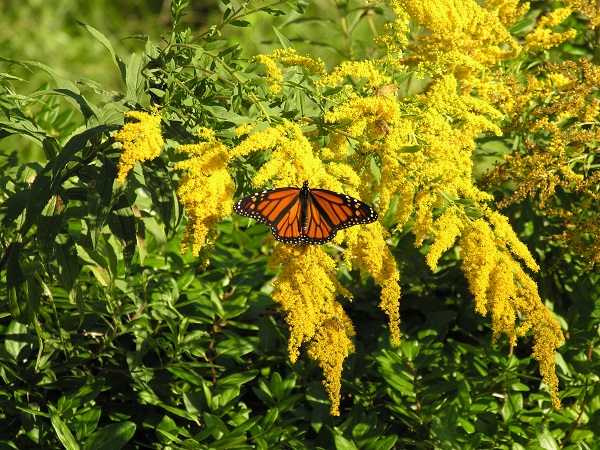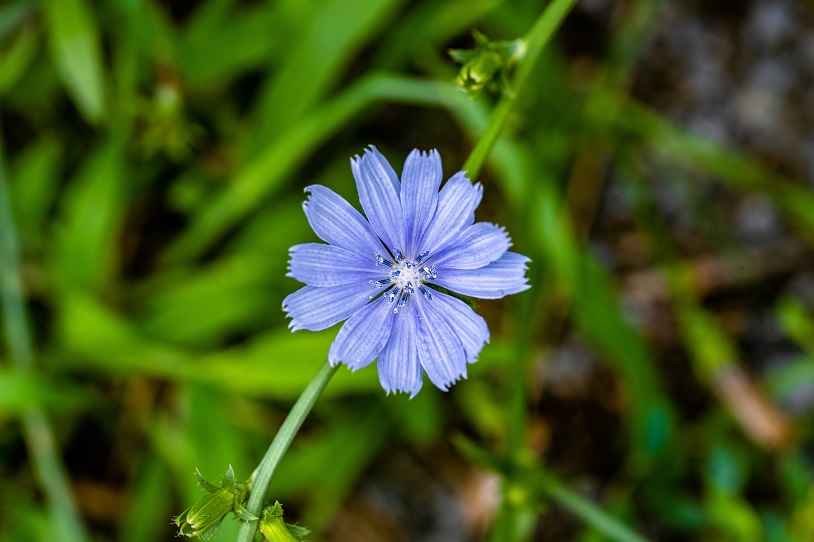Blue, gold and ah-choo! Late-summer plants of the roadsides

August is here, and the school buses are out practicing their routes. While I am waiting for a new driver to negotiate this tight turn, I notice what is blooming on the roadside. Chicory, the gentle, knee high, blue daisy-shaped flower is in its full glory right now. And it is one of the most asked about roadside plants (notice I did not say weeds).
Ah, weeds — just what is a weed? Potato, po-tah-to. Is one person’s weed just another person’s wildflower? Yes and no. There are some weeds that are actually legally noxious. But that is for another column on another day. Today is about the blue, the gold and the ahhhh-choo! Chicory, goldenrod and ragweed. The roadside plants of late summer.
Chicory is the most popular roadside plant I get questions about this time of year. How could you not notice the beautiful cornflower blue dappling the roadside? This “wild” Chicory (Cichorium intybus) is not to be confused with the lettuce red relative known as radicchio or salad chicory (Cichorium endivia var. foliosum).
The roadside flower chicory has some interesting history. Other common names include cornflower, blue sailors, coffeeweed, Italian dandelion, hendibeh, bent or succory.
Chicory originated in Europe, central Russia, and western Asia. Chicory has become naturalized throughout much of the United States and grows in horticultural zones 3-9. Chicory is a plant of disturbed ground — roadsides, poorly maintained lawns, and pastures, and grows freely in abandoned fields.
As with many imported plants, chicory came with the immigrants as part of their pharmacy — which was not from Walgreens – but from their gardens. The roots, buds and leaves of chicory were used medicinally for mild indigestion and stomach upsets, liver problems, sinus troubles and even malaria (in Afghanistan prior to the war).
The leaves of chicory are technically edible. Just like those edible flowers. From my standpoint, OK, if I was starving to death, I would consider them edible. Otherwise, I try that sleight of hand of let-me-spit-this-out-in-my-napkin-but-hope-no-one-notices. The University of Wisconsin reports, “The young leaves of even the wild type [of chicory] can be eaten raw … with a very bitter taste or older leaves can be cooked to reduce the bitterness.” Thanks, but no thanks.
But processed roots of chicory were and are still used as a coffee substitute in the southern U.S. And the variety sativum are still used in New Orleans. You can even find it on store shelves here as Café du Monde Coffee and Chicory.
In some parts of the world, chicory is used as a forage crop because the plant is toxic to parasites. Research in the U.S. is focusing on using chicory as part of a program to reduce the use of dewormers in sheep and goats. And we just think it is pretty!
Another roadside plant that gets some attention in late summer, is the shimmering bright yellow of goldenrod. Goldenrod gets a bad rap from those that think it causes allergies. It is like when the police think you were involved in a robbery just because you were in the store buying chips and pop when they were robbed. Guilt by association.
Goldenrod with its bright yellow flowers catch the eye … no one sees the nearly invisible green flowers of the real allergy producer — ragweed. Ragweed has very light pollen and is a real cause of the stuffy-nose, watery-eyed allergy sufferer in late summer.
We have two varieties of ragweed (unfortunately) in Illinois — common and giant. The common has a filigreed leaf and the giant a bigger-than-your-hand that has a trident-shape leaf. Both have similar stalk-like green flowers. It is best to eradicate it before those flowers set seed.
The confusion of the two are so pervasive that if you google ragweed, half of the images that come up, are of goldenrod; not a ragweed plant in sight. The reason it is significant to know the difference is the two grow together almost everywhere, and because the goldenrod is so obvious, and the ragweed is so camouflaged by their green-on-green leaves and flowers. Often the gardener eradicates the goldenrod, leaving the real problem growing freely.
It is even more important to allow that goldenrod to grow, whether on the roadside, or why not cultivate some varieties of it in your own garden? Goldenrod and asters are some of the latest flowering perennials in our area, robust with pollen for our smallest migrant, the Illinois State insect, the monarch.
Imagine if you were going on a long trip, but there was nothing to eat along the way? Definitely not good. For the monarch, the fourth generation, also known as the supergeneration, lives from late August through mid-September to make a 4,000-mile journey from Canada and the United States to their winter habitat in the mountains of Mexico, in the states of Mexico and Michoacán in the oyamel fir forests.
If you garden for butterflies, you have to remember their entire lifecycle. Not just of the individual, but of the species. The monarch is our smallest migrant. If you look at your own garden in the waning days of late summer, what plants have fresh blooms?
Most of our perennial plants are winding down. And if we haven’t cut back our annuals in early July, they are probably straggly and worn out. Enter goldenrod (and don’t hesitate to add some late-flowering sedum and joe pye weed.) Monarchs need lots of energy for that long flight to their winter home.

Chicory is the sky blue flower dappling the roadsides in late summer